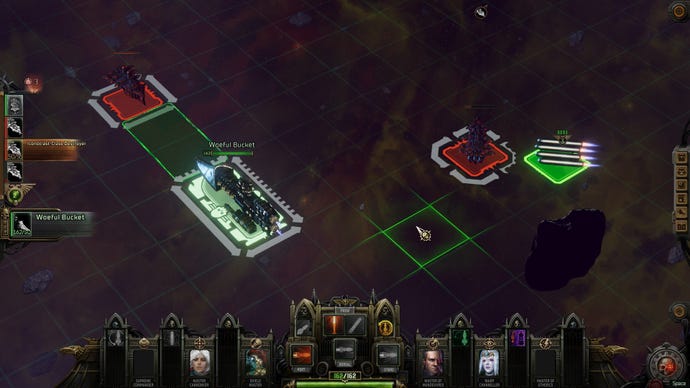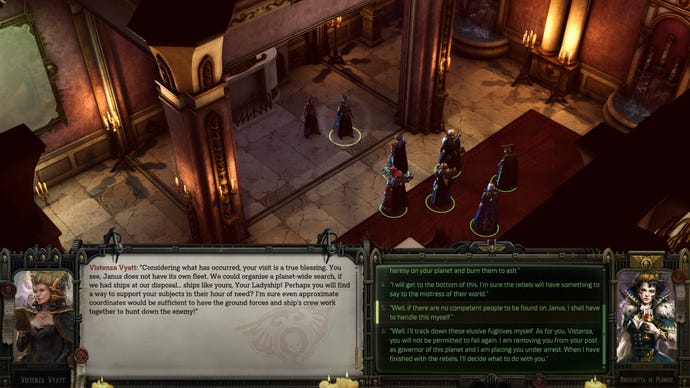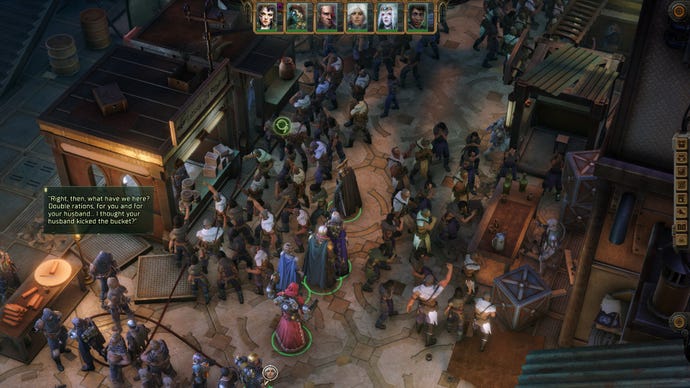In the festively grim universe of Warhammer 40,000, space is sometimes racked by Warp storms – terrible cyclones of Chaos energy that have a catastrophic effect on imperial communications. One such storm hits the Koronus Expanse during the events of Warhammer 40,000: Rogue Trader, erasing starcharts and obliging your character – a newly minted Rogue Trader, aka High Gothic Commander Shepard – to re-discover the systems and planets that make up your predecessor Theodora’s dominions, while gathering an entourage of indecently customisable warriors, and hunting down a series of badniks that include a mysterious Chaos cult.
Warp storms sometimes have relativistic consequences. Voidship crews may be stranded for decades in transit: you will meet characters in this vast, brooding RPG who arrived at their destinations to find the battles they were sent to fight already passed into legend, the people they were sent to meet long since dead or departed. Something similar has happened to this review, which was supposed to be published in early December. Did I dramatically underestimate the amount of playtime involved, despite being told months in advance by developers Owlcat that Rogue Trader is well over 100 hours long? Nonsense. It’s all because of those pesky Chaos disruptions, you see. It’s Chaos that’s to blame.
The Koronus Expanse is a fickle environment even without the Warp storms. Located on the grey fringes of the Imperium of Man, it’s a colonial melting pot of shifting allegiances and useful cynicism, where humans, xenos, mutants, heretics and true believers rub shoulders in the marketplace, and where noble dynasties plot with or against each other while their serfs prepare for revolution (often, but not always, with the discreet assistance of Chaos agents). Ranging from haunted space hulks through lush jungle planets to the crackling Tesla monasteries of the Adeptus Mechanicus, it’s a suppurating, amoral waterhole of a setting where you can strike deals with known pirates, hire Eldar rangers and openly describe yourself as a Chaos god’s anointed, without being struck down by a devouter party member – or at least, not for a good few hours of playtime.


Come to it fresh from one of the less… talkative Warhammer videogames, and you may be surprised by the, whisper it, tolerance on show. Playing as a closet Chaos worshipper with a streak of Iconoclasm (the least murderous of the game’s three philosophical alignments, defined by sympathy towards underdogs and a dislike of needless suffering), it took me a while to grasp that I could get away with pretty much anything. 20 hours in, I fell into conversation with a fire-and-brimstone cleric who pressed me about my real sympathies. I decided to go for broke and declare that, yep, I’m Team Chaos, thanks. Instead of demanding my execution, the other character burst out laughing. “Well, at least you’re honest about it.” In fairness, Rogue Traders aren’t like regular folk: they have Emperor-given license to bend the rules, providing the overall result is to bring more worlds into the Imperium’s clutches. The appeal of playing one, then, is being able to simultaneously lord over and lose yourself within a setting that is typically only depicted in videogames from the perspectives of soldiers and generals.
The Koronus Expanse is an intriguing cross-section of Warhammer 40,000’s many silly extremist ideologies. The same is true of your entourage, who make the crew of the good ship Normandy look like a bunch of mild-mannered bureaucrats. Everybody in your gallant band is some kind of weirdo bigot with suppressed violent intentions towards one or more of the rest. Every character has an absurdly convoluted origin story that stretches back centuries, including a few loyalty-quest-defining terrible secrets that soon bubble to the surface. Everybody is a mixture of friend and enemy and ticking timebomb. If you thought Ashley vs Kaiden in Mass Effect was too much stress, just wait till you meet Idira, a Psyker who is doomed to gradually succumb to demonic possession, and Argenta, a zealous Sister of Battle – both are convinced from the outset that the other one is a traitor. Deeper in, there are murdery Dark Elves, slightly less murdery non-Dark Elves and genetically engineered werewolf Space Marines with an unbridled passion for song.
Oscillating between all these viciously opposed worldviews, including an overlapping social dynamic of rich vs poor, is the most enjoyable aspect of Rogue Trader’s story. It’s less enjoyable when you fixate on the main, chapter-based plot, which is incredibly long-winded, and follows a steady rhythm of landing on a planet, talking to a few people to unlock quest areas, then traipsing across a fundamentally linear map to a movie-of-the-week villain.
Individual scenarios can be gripping – all have multiple outcomes linked to your alignment, and some have a puzzle element, such as (to pick a very early example) identifying and tracking down the right ingredients for an alchemical spawning vat. The writing is as dense and exhausting as you’d expect from a Warhammer game, but it generally keeps things lively. In particular, I always loved bringing Idira and my three-eyed Navigator, Cassia, along to chinwags, because Idira can hear disembodied spirits while Cassia sees people as colours, which leads to occasional interjections like “this man’s soul is the colour of a sewage leak on a lazy Sunday afternoon in April, and by the way, the voices say he’s got a Melta launcher down his trousers”.

There’s lots to digest, moment to moment. But where obvious rival Baldur’s Gate 3 is an outright sandbox that almost handles like an immersive sim, Rogue Trader is fundamentally a march on the waypoint, for all its opulent wording and framing. While extravagantly built, to the point that you sometimes struggle to see your characters, the tabletop-style maps harbour few exciting secrets beyond caches of loot, traps and incidental lore pop-ups. You’ll want to make a point of gathering the loot regardless, because gifting it to other factions is how you’ll raise your overall Profit Factor as Rogue Trader and gain access to juicier options from merchants.
One reason Rogue Trader is so long is that you’ll spend a lot of time playing another game within it, a game I like to call “Find The Buff”. The character customisation sees you choosing a social background, world of origin, core stats, and guiding myths and nightmares together with an “archetype” or class – a big fat Wheel O’ Unlocks with Warhammer-brand pointy bits. You gain access to one of three secondary archetypes at level 17, with a final “exemplar” archetype unlocked past level 36. In the course of filling out these archetypes, you will pile on dozens upon dozens of active and passive abilities and modifiers, a feast of options that propels Rogue Trader well beyond the XCOM reskin initially suggested by grid-based layouts of full or half-shield cover.
The range of things that can happen based on any single character action can be absolutely wild. My Eldar ranger Yrliet, for example, has unlocked an ability that causes her next shot to drive the target a few squares out of cover while inflicting reduced damage. This might shunt the target into the gaze of my Navigator, who has a passive that reduces the dodge and hit chance of any enemy she can see, making her a great partner to Yrliet.


It might also trigger a reaction attack from Idira, who I’ve transformed from a backline support into a kind of magic assassin. If the reaction attack kills the target, and one of my strutting noble characters has decreed that Idira is their Servant for this battle, it might power that noble character up in various ways. But given that Idira is wielding a cursed sword, the reaction attack might also destabilise the veil between mortal and Chaos realms, summoning a demon such as a Bloodletter, just when I thought I had the enemy on the ropes. All this, because my stupid sniper couldn’t be arsed to shoot through cover.
If you love optimising the hell out of a party and chaining their capabilities to moderately break the base systems and stat balancing, Rogue Trader is practically a class-A narcotic. One thing I especially love doing is stacking abilities that confer extra turns, movement points and action points, so as to turn one party member into a sadistic timegod, “stunlocking” the enemy team behind an infinite cascade of moves within moves within moves. Very infrequently, you can have an appropriately overclocked party member clear out a whole room before the slowest of their allies takes a single turn.
I also love the Grand Strategist archetype, who applies different buffs to certain areas and mods terrain – there’s a GS ability that gives characters a free move toward a specific patch of ground, for bonus blitzkrieg. More immediately, I get a real kick out of alternating attack types as the Arch-Militant so as to earn “versatility” and increase their Weapon and Ballistic stats.

Each battle and every turn in Rogue Trader is, in short, a frightfully complex energy transaction between characters, enemies, the terrain and the systems – a work of calculation that can be immensely gratifying but also, a real headache to follow. That’s partly inevitable when you have this many variables in play, but the presentation also obscures many of the moving parts – hence, “Find The Buff”.
Status effects are shown on a vertigo-inducing right-click character sheet, with mouse-over pop-ups that don’t quite explain enough. These pop-ups only display the initial, non-upgraded form of each unlockable trait, for example, so if you want to properly assess all the modifications you’ve made before committing to an action, you’ll need to retrace your steps through the archetype screens. The combat log, similarly, can be frustratingly recalcitrant on why, for instance, a character has just earned an extra turn or suffered Warp damage out of nowhere. I feel bad about criticising Rogue Trader’s UI designers, given how much Videogame they have to distil and express, but I would point to Darkest Dungeon 2’s system of status tokens as evidence that readability doesn’t have to be at odds with indecent tactical depth.
Rogue Trader expects you to put the work in to understand these things. It also expects you to be good at visualising scenarios based on arcane maths equations. Each unlock slot on the archetype wheel corresponds to several tabbed lists of generic and specialised abilities or traits, together with weapon or equipment proficiencies and basic stat buffs.

As I noted in my write-up for embargo, picturing them in action takes a lot of effort. You’ll peer at the descriptive text like a novice monk practising their Latin, and gradually realise that ah, what this basically does is punish an enemy for moving or being moved. It can be a fun challenge, but again, a touch more transparency would have made a big difference: in particular, presenting all the level-up options as tabbed lists makes them feel interchangeable, with too little visual variation between icons. As it is, while I did enjoy wrestling with the intricacies, I’ve never played an RPG in which the sight of a level-up notification made me quit more often than Rogue Trader. I’ve also played few RPGs that are as hard to pick up after an extended absence: you have to spend at least a session remembering what all your characters do.
The difficulty memorising the specifics is exacerbated by the fact that many of the game’s battles are filler, particularly on Normal difficulty – there are lots of granular difficulty options to fiddle with, but to understand how they affect the game, you’ll need to play a couple dozen hours on a default setting. Boss fights against demons and the like with very specialised quirks and super-moves are a delight to figure out. Scraps with Cutthroat Rebel and his many, many associates are just there to slow you down. This is a charge I would sadly level against much of Rogue Trader, including the space battles featuring your private voidship, which are simplified turn-based skirmishes with the additional problem of inertia and turning circles.
Had I tried to write up Rogue Trader for embargo, I suspect I would have disliked it a lot more. Much as I try to distance myself from questions of size, having a game like this vast lobbed at your calendar inevitably leads to exhaustion and frustration. Rogue Trader is a lot more entertaining when you can dip in as you please, providing you keep copious notes, but even then, there will be moments when you feel overwhelmed. The game’s appetite for the pomp and pageantry of Warhammer 40,000 is at once its best and worst quality. Sometimes, it’s a gorgeously Gothic gateaux noir that teems with strange and different flavours, such that you can spend hours guessing at the ingredients. But sometimes the flavours obliterate each other, and you just feel like you’re trying to swallow a cathedral.










